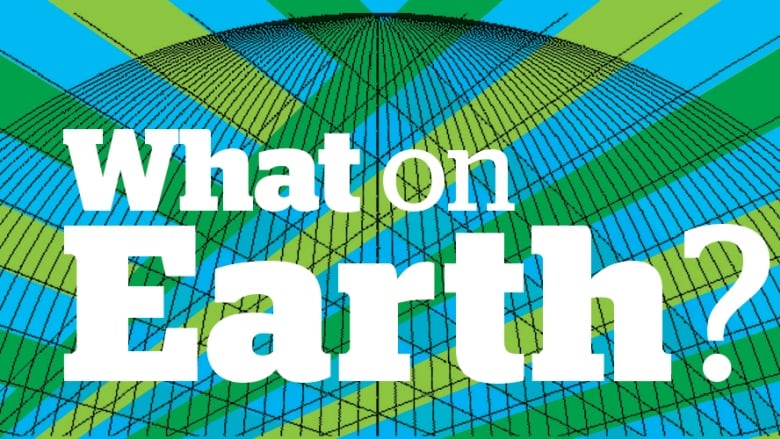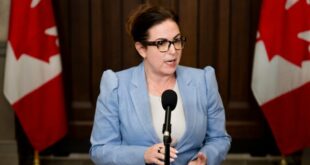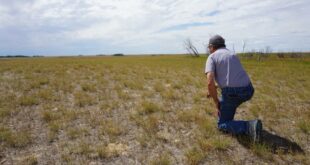Also: What’s a greenbelt supposed to do?

Our planet is changing. So is our journalism. This weekly newsletter is part of a CBC News initiative entitled “Our Changing Planet” to show and explain the effects of climate change. Keep up with the latest news on our Climate and Environment page.
Sign up here to get this newsletter in your inbox every Thursday.
Also this week:
- Climate action in New York: A week to remember
- What’s a greenbelt supposed to do?
California is suing Big Oil over climate ‘deception.’ Could the same happen in Canada?

Dozens of lawsuits have been filed in recent years against the fossil fuel industry for its role in the climate crisis.
But few compare in scope and significance to the case being pursued in California, the world’s fifth-largest economy and a major oil and gas producer.
Filed last Friday, the 135-page lawsuit argues some of the world’s largest oil and gas companies — ExxonMobil, Shell, Chevron, ConocoPhillips and BP — deceived the public about the risks of fossil fuels and seeks a compensation fund to pay for future damages caused by climate-related disasters in California.
“The climate crisis is, after all, a fossil fuel crisis,” California Gov. Gavin Newsom (photo above) said this week, insisting the lawsuit can help “illuminate [oil companies’] deception and their lies — over the course of 50, 60, 70 years, they’ve been lying to you.”
The long list of allegations in the suit includes false advertising, misleading the public about what the industry’s own research showed about the impact of fossil fuel emissions and delaying the transition to renewable energy.
The suit says oil and gas company executives were aware of the potential warming effects of greenhouse gas emissions as early as the 1950s, but made efforts to “cast doubt in the public’s mind about the burgeoning scientific consensus on climate change.”
Among the many examples:
-
In 1979, an internal Exxon memo stated increasing CO2 concentration will “cause a warming of the Earth’s surface” and the “present trend of fossil fuel consumption will cause dramatic environmental effects before the year 2050. The potential problem is great and urgent.”
-
In 1988, an Exxon memo laid out a strategy to emphasize “the uncertainty in scientific conclusions regarding the potential enhanced greenhouse effect.”
-
In 1998, the American Petroleum Institute (API), also named in the suit, convened an organization known as the Climate Science Communications Team (GCSCT), whose members included oil company employees and no climate scientists. The goal, according to a memo, was to develop and implement “a national media relations program to inform the media about uncertainties in climate science” and “begin to erect a barrier against further efforts to impose Kyoto [Protocol]-like measures in the future.”
Many of these details have been brought to light by investigative reporting, and the revelations keep coming. A report in the Wall Street Journal last week found Exxon undermined climate science through at least 2015, and specifically tried to twist the science of the UN’s Intergovernmental Panel on Climate Change (IPCC).
Exxon CEO Darren Woods told the Journal “when taken out of context, it seems bad.” But Woods said “we’re building an entire business dedicated to reducing emissions — both our own and others — and spending billions of dollars on solutions that have a real, sustainable impact.”
The API and oil companies named in the suit said that climate policy should be debated in the U.S. Congress, not the courtroom.
Andrew Gage, a staff lawyer with West Coast Environmental Law in Vancouver, said the California lawsuit is significant, even if the legal context is different in the U.S.
“It brings this to a new level, in terms of helping people wake up and realize that governments increasingly are having to turn to these types of lawsuits to recover the cost of climate change on behalf of their citizens,” he said.
There have been 35 climate-related legal challenges in Canada, according to Columbia University’s climate litigation database, but none against corporations — only governments.
Experts believe that is likely to change.
“Big emitters like fossil fuel companies — absolutely they need to be aware of their potential exposure … in terms of potential liability,” Nathalie Chalifour, a law professor at the University of Ottawa who has been tracking climate litigation for more than a decade, said recently.
West Coast Environmental Law is among those spearheading the Sue Big Oil campaign in B.C., which aims to compel local municipalities to sue oil companies for environmental damage caused by the use of fossil fuels. Two municipalities have signed on so far: View Royal and Gibsons.
Gage had hoped to file a suit in connection with B.C.’s deadly 2021 heat wave, which scientists have said would have been “virtually impossible without human-caused climate change.” But the two-year statute of limitations expired this summer. (A county in Oregon filed a suit in June.)
This year’s record-breaking wildfire season presents another opportunity, Gage said.
“It is the matter of public narrative, and making sure people understand that these costs are climate disasters, not natural disasters,” he said.
— Benjamin Shingler
Old issues of What on Earth? are here. The CBC News climate page is here.
Check out our radio show and podcast. What On Earth airs on Sundays at 11 a.m. ET, 11:30 a.m. in Newfoundland and Labrador. Subscribe on your favourite podcast app or hear it on demand at CBC Listen.
Watch the CBC video series Planet Wonder featuring our colleague Johanna Wagstaffe here.
Reader feedback
John Lyons responded to Emily Chung’s story on ocean carbon capture:
“All of the proponents of different types of carbon storage never finish their sentences: ‘so that we can keep burning fossil fuels.’ We have to greatly reduce the burning of fossil fuels before we blast past a tipping point.”
Also, in last week’s newsletter, our photo caption incorrectly suggested that researchers from Planetary Technologies were on the boat pictured, and that the “antacids” were added to the water from the boat. In fact, the antacids were added from a different, nearby location as part of Planetary Technologies’ ocean alkalinity enhancement test. The researchers on the boat were actually from Dalhousie University, and were conducting independent measurements of the experiment by Planetary Technologies.
Write us at whatonearth@cbc.ca.
Have a compelling personal story about climate change you want to share with CBC News? Pitch a First Person column here.
The Big Picture: A week of climate action in New York
![A billboard reading 'Megafire powered by [Shell logo]' is projected on the side of a building in a metropolis at night.](https://i.cbc.ca/1.6974140.1695316762!/fileImage/httpImage/image.jpg_gen/derivatives/original_780/anti-fossil-fuel-billboard.jpg)
It can be hard to keep track of the various climate summits — and we say that as people who cover this beat. But some events stand out more than others. And Climate Week NYC, from Sept. 17 to 24, has given us a number of indelible moments.
The annual event, which has been staged since 2009, runs parallel to the United Nations General Assembly and brings activists, businesspeople and politicians together in New York to discuss climate action. This year’s many speakers include actor and longtime activist Jane Fonda, former Canadian environment minister Catherine McKenna and UNICEF climate lead Gautam Narasimhan.
Protesters made a big impression at this year’s event, finding novel ways of making their point about the culpability of the fossil fuel industry — and its facilitators — in global warming. For example, three days before the summit began, demonstrators from New York Communities for Change encircled the New York headquarters of Citigroup, effectively barring employees and customers from getting inside (there were several arrests). Protesters justified their action by saying the U.S. bank funds the oil and gas industry.
Earlier this week, demonstrators did a similar thing outside the offices of the U.S. Federal Reserve in New York; New York Communities for Change said, “Fossil fuel companies … wouldn’t be able to operate without money, and that money is coming primarily from Wall Street.”
Later in the week, activists projected massive billboards on the side of a hotel in lower Manhattan that linked climate disasters with specific oil and gas companies (“Megafire powered by [Shell logo],” “Extreme flood powered by [BP logo]”).
At a Climate Week NYC event on Monday, California Gov. Gavin Newsom delivered a broadside against the oil and gas industry that was notable for its directness, especially for a sitting politician. As mentioned above, his state has just filed a lawsuit against the five biggest oil and gas producers for sowing distrust about the effects of fossil fuels on the environment. Referring to the wording of the lawsuit, Newsom said, “you cannot read it without crawling out of your skin. The level of deceit — it’s not even debatable now. We have the receipts. It’s overwhelming.”
Hot and bothered: Provocative ideas from around the web
-
Dust particles produced by vehicle tire wear are full of toxic chemicals shown to harm fish and pose human health risks, scientists find. Now, companies and researchers are looking for solutions.
- Toronto will consider banning gas-powered Uber, Lyft and taxi cars by 2031. City staff have recommended the ban, along with a fund to help the industry transition to zero-emission vehicles.
- Ever been shocked by the ultra-cheap plane tickets in Europe? They could soon be banned. France is asking the EU for support to set a minimum price on airfares to help cut aviation emissions.
-
A large methane leak from a U.K. gas main was spotted by University of Leeds researchers using a satellite, suggesting this method could be used to identify and stop leaks of the potent greenhouse gas sooner.
What’s a greenbelt supposed to do?

In 45 years of farming beans, wheat and corn on his rolling acreage in Campbellville, Ont., Peter Lambrick has seen more change than he can recount in one conversation.
But he can recall the early days when Ontario’s Greenbelt was just a rumour travelling between farms in 2004.
The provincial Liberal government at the time was planning to establish the protected area to stop urban sprawl, which was gobbling up rich farmland and environmentally sensitive areas in southern Ontario. Lambrick said some farmers felt cheated by the idea because it meant they wouldn’t be able to sell their land to deep-pocketed developers.
“There was a lot of angst,” said Lambrick, 72, a local industry fixture and former chair of the GTA Agricultural Action Committee. “There were many people that were very vocal, but they were more likely the farmers who felt that they had been hard done by.”
Eventually established in 2005, the Greenbelt is a protected area of land over the Greater Toronto Area that’s meant to be permanently off-limits to developers. At 810,000 hectares in size, it’s a rich stretch of farmland, forest and wetland that’s larger than Prince Edward Island, making it the largest greenbelt in the world.
Nearly two decades later, Lambrick said the heat has died down — at least among most farmers. It recently became the subject of political controversy for the Ontario government, which was intent on developing parts of the Greenbelt for housing, in a process the auditor-general found was influenced by well-connected developers.
Lambrick and industry experts agree the Greenbelt has not only accomplished its original purpose of containing city growth, but has also helped offset the effects of climate change — which they argue should be today’s higher purpose.
It’s rare that there’s a consensus among economists, urban planners and environmentalists, “butno one will tell you that it’s a good idea to get rid of the Greenbelt,” said Diane Laure Arjaliès, an associate professor at Western University’s Ivey Business School in London, Ont.
Greenbelts have been used to protect farmland, food supply, biodiversity and water quality and to influence development around the world, from San Francisco to Los Angeles to Melbourne to Amsterdam. In London, England, patches of protected green space were used as buffers to prevent distinctive towns from melting together.
They don’t always succeed at stopping cities from spreading. A horseshoe-shaped greenbelt around the city of Ottawa has been federally managed since the 1950s. But unlike its Ontario neighbour, there aren’t laws in place to protect it from development.
Some farmers, environmentalists and urban planners see this type of land as sacred. Developers see it as an arbitrary obstacle that has made housing problems worse because it cuts off access to land where new homes could be built, driving up the price of existing land across the region.
Last year, a provincially commissioned report said the Greater Toronto Area has enough land outside the Greenbelt — it’s just not being used to its full potential, bogged down by inefficient housing policy.
“Ideally, you need both sides of the coin: You need the Greenbelt to protect the land and [you need] policies within the city that let people build more so that the development pressure doesn’t build up,” said Shoshanna Saxe, an associate professor of civil and mineral engineering at the University of Toronto.
The Greenbelt in southern Ontario became politically controversial in December 2022, when the provincial government removed nearly 3,000 hectares of land from the protected space, opening it up to the construction of 50,000 new homes. At the same time, the government added nearly 4,000 hectares of new land to the Greenbelt elsewhere.
Resistance was intense, as residents and opposition politicians worried it was a slippery slope. The backlash intensified when an auditor general’s report found politically connected developers who stood to make billions of dollars on the land swap had influenced the deal. On Thursday, Premier Doug Ford announced he was reversing the land-swap plan.
Saxe said building on the Greenbelt is short-sighted because the area cleans the air, absorbs excess rainwater, keeps development away from watersheds, provides wildlife habitat and offers recreation space like hiking trails and paths — all of which should continue in a warming world.
“If you care about climate change, we should protect the Greenbelt,” Saxe said.
Arjaliès said the Greenbelt “plays a key role in climate [across] the entire continent.”
“People don’t realize it, but what’s happening here, it’s going to impact Quebec, it’s going to impact Manitoba, it’s going to impact the U.S.”
— Rhianna Schmunk
Stay in touch!
Are there issues you’d like us to cover? Questions you want answered? Do you just want to share a kind word? We’d love to hear from you. Email us at whatonearth@cbc.ca.
Editor: Andre Mayer | Logo design: Sködt McNalty
*****
Credit belongs to : www.cbc.ca
 Atin Ito First Filipino Community Newspaper in Ontario
Atin Ito First Filipino Community Newspaper in Ontario






